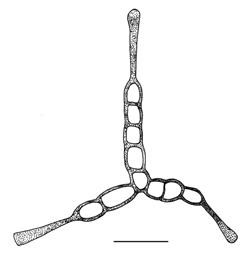Fungalpedia – Note 150, Alleppeysporonites (Fossil Fungi)
Alleppeysporonites Ramanujam & K.P. Rao.
Citation when using this data: Saxena RK & Hyde KD. 2024 (in prep) – Fungalpedia, Fossil Fungi.
Index Fungorum, Facesoffungi, MycoBank, GenBank, Fig. 1
Classification: Ascomycota incertae cedis
The monotypic fossil genus, Alleppeysporonites, was described from the Quilon and Warkalli beds (Miocene, 23–5 mya) of Kerala along the west coast of South India. It was also rarely seen in the clay samples of the Padappakkara area (Ramanujam & Rao 1978). Alleppeysporonites was diagnosed as follows: “Spores branched, brownish, multicellular, inaperturate, septa transverse, and branches one or two per spore, gently curved. Basal and terminal cells each have a conspicuous appendage. The spore wall is psilate to scabrate.” The branched nature and the presence of appendages are essential features of this spore type. The fossil taxon resembles the dematiaceous asexual Ascomycota Grallomyces (Barnett 1956, Ellis 1971, Subramanian 1971). The appendages of the fossil are similar to the stalked attachment organs of Grallomyces conidia. The spore wall of Grallomyces is minutely verrucate, while in fossil spores, it is essentially scabrate. Only one species listed in Index Fungorum (2023) under this genus and it is placed in Ascomycota incertae sedis.
Type species: Alleppeysporonites scabratus Ramanujam & K.P. Rao
Figure 1 – Alleppeysporonites scabratus. Scale bar = 20 μm Redrawn from Ramanujam and Rao (1978).
References
Ellis MB. 1971 – Dematiaceous Hyphomycetes. Commonwealth Mycological Institute, Kew, England, 608 p.
Entry by
Ramesh K. Saxena, Birbal Sahni Institute of Palaeosciences, Lucknow, India
(Edited by Kevin D. Hyde, Samaneh Chaharmiri-Dokhaharani, & Achala R. Rathnayaka)
Published online 9 October 2023
